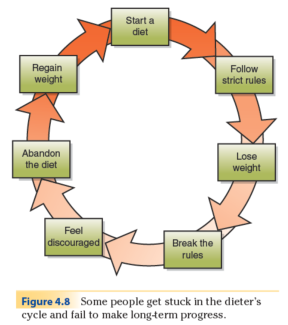Dieting options in the United States
This is an excerpt from Health and Wellness for Life With Online Study Guide by Human Kinetics.
Dieting in the United States
The diet industry in the United States is lucrative. New eating plans are constantly popping up, and old ones resurface. Establishing a healthy eating plan that you can maintain for the rest of your life is the key to successful weight management.

Dieter's Cycle
The term dieting can mean different things to different people. For some, it's the simple desire to lose weight. For others, it's the periodic, short-term use of a weight-loss behavior. For still others, it's just trying to maintain their current weight. For many, however, dieting often leads to a dieter's cycle: Start a new diet, follow strict rules about food and eating, experience weight loss, break the diet rules, feel discouraged and guilty, abandon the diet, regain weight, and start the next new diet (see figure 4.8). This pattern of restriction, weight loss, disinhibition, and weight gain can be emotionally and possibly even physically damaging.

Weight cycling, or yo-yo dieting, is the repeated loss and regain of body weight. Cyclers might lose and regain 5 to 10 pounds (2 to 4.5 kilograms) or as much as 50 pounds (22.5 kilograms) or more. The jury is still out on whether weight cycling results in health problems. Some studies suggest that weight cycling may increase the risk of high blood pressure, high cholesterol, and gallbladder disease. Other studies suggest there
is no link between weight loss and regain and physical health. Even less is known about the effects of weight cycling on behavior and psychological factors. People who perceive themselves as weight cyclers tend to have lower self-esteem, body image, and life satisfaction.
In general, if you need to lose weight, avoid dieting and instead prepare to make sustainable healthy lifestyle changes. A healthy eating plan and physical activity are the keys to success.
Popular Diets
Many people who want to lose weight attempt the latest diet to hit the market, and the next one, and the next one, and each tends to have short-lived success. Most popular diets lead to some initial weight loss simply because the dieters cut down on their food intake and watch what they eat. Diet fads change with time, but diet plans tend to cluster into three types: low-carbohydrate, high-protein diets; low-fat diets; and novelty diets.
Low-Carbohydrate, High-Protein Approaches
Low-carbohydrate, high-protein diets are in fashion again. Diets such as Protein Power, Dr. Atkins' New Diet Revolution, and Sugar Busters all severely restrict foods that contain starches and sugars. These diets revisit an idea that became popular in the 1970s (with historical roots going back 200 years): Carbohydrate makes us fat. The protein in these diets often comes from animal sources, meaning that fat, saturated fat, and cholesterol intake can be high. The Nutrition Committee of the American Heart Association (AHA) has issued a science advisory warning that high-protein diets have not been proven effective and pose health risks (St. Jeor et al. 2001). The report covered the Atkins, Zone, Protein Power, Sugar Busters, and Stillman diets. The committee stated that although these diets might not be harmful for most healthy people for a short time, there are no long-term scientific studies to support their overall efficacy and safety. In high-protein diets, weight loss is initially high due to fluid loss related to reduced carbohydrate intake, overall calorie restriction, and ketosis-induced appetite suppression (ketosis is when the liver burns fat instead of glucose for energy).
Low-Fat Approaches
Dietary Guidelines for Americans 2005 recommends maintaining a healthy eating plan that has a total fat intake between 20 and 35 percent of total calories (USDHHS and USDA 2005). Very-low-fat diets (which often turn out to be high-carbohydrate diets) are even more restrictive. Generally, diets of this nature, such as the Pritikin program and Dr. Dean Ornish's program, recommend that about 5 to 10 percent of calories come from fat. This approach is generally not harmful for healthy adults. People adopting a very-low-fat eating plan consume large amounts of whole grains, fruits, and vegetables. However, this diet so different from the typical North American lifestyle that it could be hard for people to sustain over the long term.
Novelty Diets
Many diets are simply gimmicks. Most of them focus on one specific food or food group (e.g., the grapefruit diet) and exclude almost all others. For example, the rice diet was designed in the 1940s to lower blood pressure, and it has resurfaced as a weight-loss diet. The logic behind many of these diets is that you will only be able to eat so much of the select food for so long before becoming bored, so you'll reduce your calorie intake. The reality is that most people are not able to eat only one or a few foods for an extended length of time, so they get frustrated, quit the diet, and regain weight quickly.
Very-Low-Calorie Approaches
A very-low-calorie diet (VLCD) is used to help treat severe obesity (BMI at or above 30), particularly if a person has obesity-related diseases such as type 2 diabetes. VLCDs are usually doctor supervised and use commercially prepared formulas to promote rapid weight loss. The formulas often contain appropriate amounts of vitamins and micronutrients to help prevent nutritional deficiencies that are likely to occur at such low calorie levels (often fewer than 800 calories a day). VLCD formulas are not the same as over-the-counter meal replacements found at grocery stores or pharmacies, which are meant to substitute for one or two meals a day. Under the proper medical supervision, VLCDs can help jump-start weight loss in a moderately to extremely obese person at the rate of 3 to 5 pounds (1.3 to 2.2 kilograms) per week. Studies show that the long-term effectiveness of VLCDs varies widely, but weight regain is common. Combining a VLCD with behavior therapy, physical activity, and active follow-up treatment may help increase weight loss and prevent weight regain.
To be successful with weight management for the long term, people need to find and adopt a healthy eating and activity plan that addresses dietary intake, eating behavior, and physical activity. The plan should avoid leaving people feeling deprived so that they can maintain the plan for the long term.
Healthy Weight-Control Programs
Weight-loss and weight maintenance programs should encourage healthy behaviors that you can stick with every day. Safe and effective weight-loss programs should have these components (National Institute of Diabetes and Digestive and Kidney Diseases [NIDDK] 2008):
- Healthy eating plans that reduce calories but don't forbid specific foods or food groups.
- Tips to increase moderate-intensity physical activity.
- Tips on healthy behavior changes that also keep your cultural needs in mind.
- Slow and steady weight loss. Depending on your starting weight, experts recommend losing weight at a rate of .5 to 2 pounds (.2 to .9 kilogram) per week. Weight loss may be faster at the beginning of a program.
- Medical care if you are planning to lose weight by following a special-formula diet, such as a VLCD.
- A plan to keep the weight off after you have lost it.
To determine if a weight-control program meets those guidelines, gather as much information as possible about the program before you start. The five questions that follow will help you be a smart consumer and gather information so you can separate good weight-control programs from bad programs.
1. What does the weight-loss program consist of?
- Does the program offer one-on-one counseling or group classes?
- Do you have to follow a specific meal plan or keep food records?
- Do you have to purchase special food, drugs, or supplements?
- Does the program help you be more physically active, follow a specific activity plan, or provide exercise instruction?
- Does the program teach you to make positive and healthy behavior changes?
- Is the program sensitive to your lifestyle and cultural needs?
2. What are the staff qualifications?
- Who supervises the program?
- What type of weight management training, experience, education, and certifications do staff members have?
3. Does the program carry any risks?
- Could the program hurt you?
- Could the recommended drugs or supplements harm your health?
- Do participants talk with a doctor?
- Does a doctor run the program?
- Will the program doctors work with your personal doctor if you have a medical condition such as high blood pressure or are taking prescribed drugs?
4. How much does the program cost?
- What is the total cost of the program?
- Are there other costs, such as weekly attendance fees, food and supplement purchases, and so on?
- Are there fees for a follow-up program after you lose weight?
- Are there other fees for medical tests?
SHOP

Get the latest insights with regular newsletters, plus periodic product information and special insider offers.
JOIN NOW


